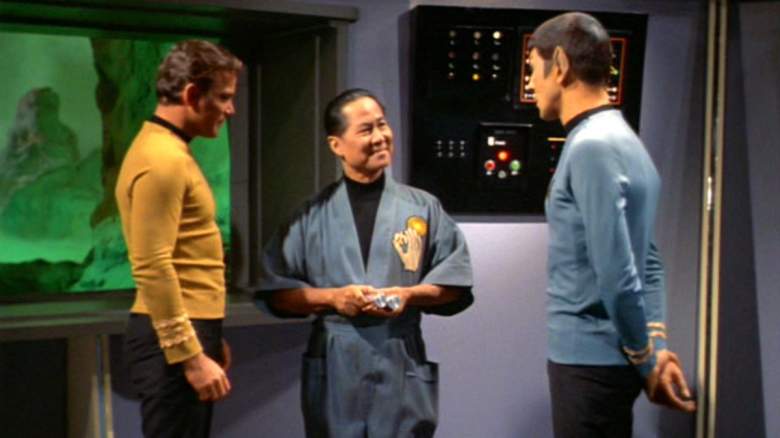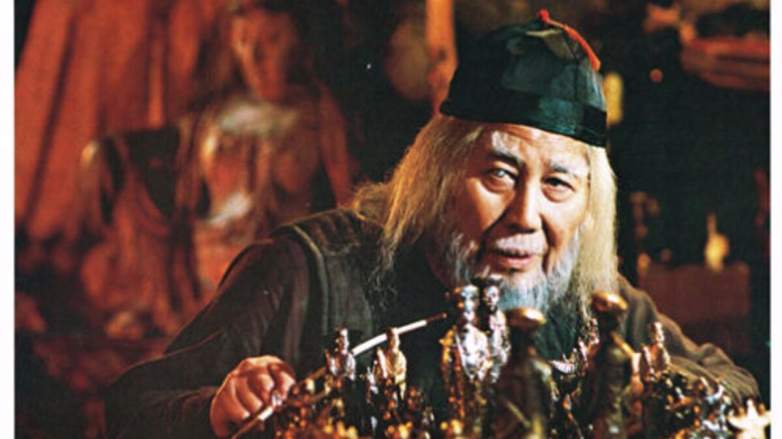
Paramount Keye Luke with William Shatner and Leonard Nimoy in a scene from "Whom Gods Destroy."
Other “Star Trek” guest stars played far bigger and more profound roles than did Keye Luke, who portrayed Donald Cory in “The Original Series” episode, “Whom Gods Destroy,” which, according to Memory Alpha, was the 16th episode of the show’s third and final season. The episode’s other main guest stars, Steve Ihnat as Garth and Yvonne Craig as Marta, got to chew far more scenery. Still, many fans recognize the importance of Luke’s involvement in “Star Trek,” and his place in the entertainment industry.
Luke was born in China and raised in Seattle, Washington, according to his biography on the Hollywood Walk of Fame website. Luke later spent decades as one of the most in-demand Asian actors working in America’s entertainment industry, according to the Internet Movie Database. Universal Pictures, Metro-Goldwyn-Mayer, and RKO each inked deals with Keye to secure him as their first Asian contract player.
According to the Internet Movie Database and Playbill.com, his many credits included the “Charlie Chan” film series, the “Green Hornet” film serials, the original 1958 Broadway cast of “Flower Drum Song,” “Here’s Lucy,” “Kung Fu” (as Master Po), “M*A*S*H,” “T.J. Hooker” (with William Shatner), “Space Ghost,” “Gremlins” and “Gremlins 2: The New Batch,” “Sidekicks,” “MacGyver,” “Superboy,” and his final film, “Alice,” which was released in 1990.
Luke Only Made One Appearance in the ‘Star Trek’ Universe, But it Was Memorable & Important

Warner Bros.Keye Luke in a scene from “Gremlins.”
Luke entered the “Star Trek” universe in 1969, when the original show was in what turned out to be its final season. There were few roles, and fewer of substance, for Asian and Asian American actors at the time. Cory, Luke’s character in “Whom Gods Destroy,” served as governor of the insane asylum, Elba II,” according to Memory Alpha. A decent man eager to support those under his care, Cory is overtaken by Garth of Izar, a former Starfleet captain turned madman turned shapeshifter. Garth actually poses as and later tortures both Cory and Kirk in a quest to steal the Enterprise and wreak vengeance on his enemies. Cory’s nationality is of no consequence.
“One of my prisoners got the will of power and schemed, captured me, and tied me up,” Luke remembered in a 1988 interview with the magazine Starlog. “I was put into a special torture chair. But, of course, I was rescued in the nick of time by William Shatner. Leonard Nimoy. and the rest of them…
“I was scheduled to leave for England the day to show finished, but I couldn’t because the torture chair with such an elaborate electronic affair that they couldn’t get it finished in time, so I had to stay over an extra day,” he continued. “My agent came down to the set, and I went with him in his little Volkswagen, taking off my costume and removing my makeup as we drove to the airport.”
Luke’s Career Spanned from 1934 to 1990, with His Final Role in Woody Allen’s Film, ‘Alice’
Luke’s episode of “Star Trek: The Original Series” proved to be one of more than 300 television and film credits he amassed throughout his career, according to IMDB, which started in 1934 with an uncredited appearance in “The Painted Veil” and, as noted, ended in late 1990 with the Woody Allen film, “Alice” ( which also featured Diane Salenger, who, according to Memory Alpha, later guest-starred in the “Deep Space Nine episodes, “Shakaar” and “The Darkness and the Light”). Nevertheless, Luke noted in an interview, when people noticed him out on the street, they often asked about his brief trek to the 23rd century. “It seems that anybody who was on (“Star Trek”) became kind of a universal character,” he told Starlog. “Everybody has seen the show and they recognize you from it. But of course, its popularity gained with time and has not diminished.”
Luke suffered a stroke and passed away on January 12, 1991, according to his obituary in the New York Times, only a couple of weeks after “Alice” arrived in theaters and after he’d been honored with a Star on the Hollywood Walk of Fame. Luke earned positive reviews for his entertaining performance in “Alice” as a cranky hypnotist and herbalist. “I am very, very grateful at this time and at this point in my total career,” he told Starlog. “I can still produce and satisfy and go on. It’s as new to me today as it ever was. I said to myself, ‘Look, aren’t you lucky at this age, at this time in Hollywood, you’re still up and around and producing and delivering in the drama and working. So, be thankful, and go out there with a song in your heart.”